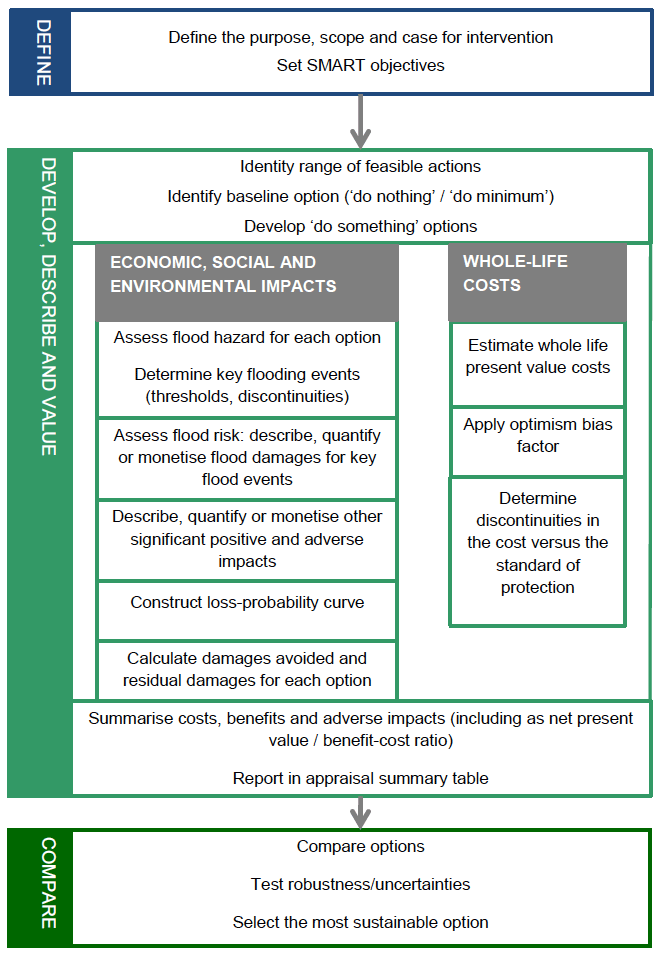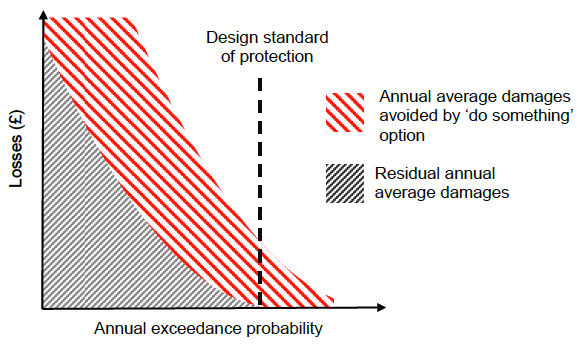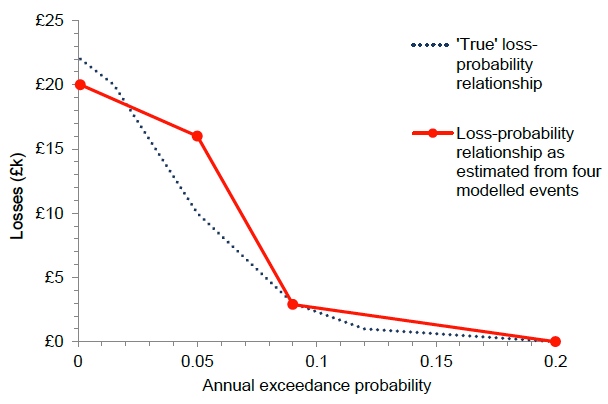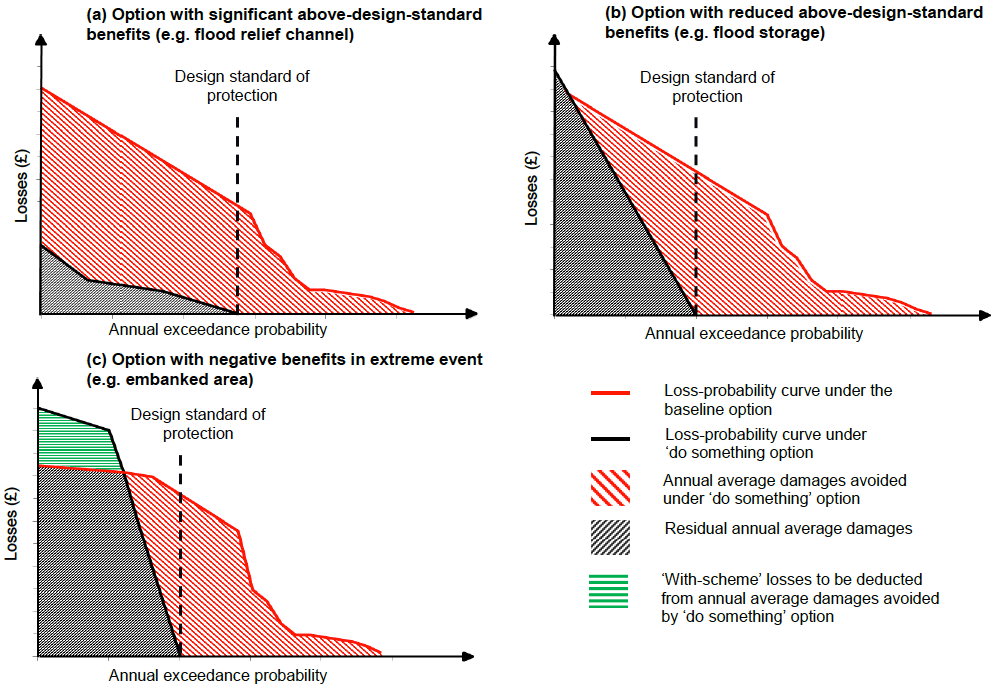Flood protection appraisals: guidance for SEPA and responsible authorities
Appraisal guidance for the Scottish Environment Protection Agency (SEPA) and responsible authorities.
9. Estimating flood risk management benefits
9.1. Introduction
9.1.1. Guidance is provided here on how to estimate the flood risk management benefits of different options.
9.1.2. A summary of the key steps is shown in Figure 9.1. These are:
- Establish the expected flood hazard for each option;
- Describe, quantify and, where appropriate, monetise the expected damages for the baseline and the 'do something' options;
- Construct loss-probability curves for monetary damages;
- Estimate flood risk benefits (damages avoided) for 'do something' options.
9.2. Expected flood hazard
9.2.1. The baseline ('do nothing' or 'do minimum') flood hazard needs to be established, along with the expected flood hazard for the 'do something' options, for a range of exceedance probabilities (see Section 9.5). Flood hazard can include the consideration of the depth, extent, velocity and duration. Appraisers will need to select the most appropriate components of flood hazard to assess, based on the type of appraisal and the site in question. SEPA (2015a) provides more guidance on modelling the flood hazard for strategic, feasibility and design studies.
9.2.2. Changes in flood hazard both upstream and downstream of the action and/or along the adjacent coastal areas must also be assessed (see Section 5.4 for consideration of spatial boundaries).
9.2.3. Not all 'do something' options will lead to a change in flood hazard. Non-structural actions such as flood warning or property level protection typically alter the impacts of flooding rather than flood hazard itself (Section 9.3.5).
9.3. Changes in flood damages
9.3.1. Having established any changes to flood hazard, the appraisal should then estimate the change in flood damages under the 'do something' options compared to the baseline. This will need to be assessed for a number of exceedance probabilities (return periods) for each option.
9.3.2. The benefits of flood risk management are estimated as the flood damages avoided by the 'do something' option compared to the baseline option. For monetary benefits, these are usually presented as the expected value of annual average damages avoided. For non-monetary benefits, this information needs to be presented and summarised in a descriptive or quantitative way.
Figure 9.1: Flow chart for flood risk management appraisal

9.3.3. The appraisal must also consider where flood hazard might lead to an altered flood risk upstream and downstream of the action and/or along the coast (Section 9.2.2). Any remedial action required to address an increase in flood risk elsewhere should be considered as a cost (see Appendix 1, Section A1.3).
9.3.4. Where flood damages can be expressed in monetary terms, then flood damages for a selection of return periods can be used to construct loss-probability curves (Section 9.5). For non-monetised impacts, damages should be described and, if possible, quantified and reported for different exceedance probabilities where appropriate.
9.3.5. Where non-structural actions, such as property level protection or flood warning, lead to changes in flood impacts rather than flood hazard, the benefits may be captured by altering the expected losses for a range of exceedance probabilities. (See, for example, the strategic assessment of flood risk management benefits of property level protection by JBA (2014)). Further guidance is provided in the MCM. Where large components of the benefits may be expressed in non-monetary terms rather than monetary terms, multi criteria approaches may be particularly useful.
9.4. The upper limit to damages
9.4.1. Care should be exercised where the total present value of damages exceeds the current write-off value of the receptor. For residential and non-residential properties, this is discussed in Section 6.2.
9.4.2. In the case of other receptors, such as roads, railway lines, pipelines or cables, there is the potential for very large values to be generated for long-term disruption. Theoretically, it would be reasonable to assume that the maximum economic benefit to the receptor will be equal to the economic cost, depreciated to allow for the age of the existing receptor, of reconstructing an equivalent facility at a higher level, or on an alternative alignment, which avoids the flood risk. However, appraisers should avoid investing disproportionate time in estimating a capping limit for these damages, particular as the costs of relocating these types of receptors are likely to be extremely high and rarely less than the expected damages.
9.5. Constructing loss-probability curves for monetary damages
9.5.1. Loss-probability curves are used to determine the difference in monetary damages between the baseline and a 'do something' option. The value of annual flood damages is calculated as the probability of a range of events multiplied by the damage caused for such an event.
9.5.2. In practice, the benefits are measured by the difference in the areas under loss-probability curves for the baseline and 'do something' options. This difference in area is the expected value of the damages avoided each year over the life of the option (Figure 9.2) - i.e. the annual average benefits. These are discounted over the life of the option to give the present value of the benefits.
Figure 9.2: Determination of annual average damages avoided

9.5.3. The loss-probability curve is generally calculated using only a very small sample of all possible flood events that might be considered. The overall shape of the curve and the area under it is derived by drawing straight lines between the calculated points. This can, potentially, result in wrong estimates of the area under the curve. In Figure 9.3, the choice of flood events when compared to the 'true relationship has resulted in a significant overestimate of the overall losses.
9.5.4. Determining how many and which flood events to include is a sampling problem. The aim is to obtain a reasonably close approximation to the loss-probability curve representing an infinite number of flood events if these were to be modelled.
9.5.5. The ideal events to use are those located at the points on the curve where there is a disproportional change in loss compared to the change in probability (i.e. a significant change in the gradient of the loss-probability curve) - these points are known as discontinuities. The easiest way to ensure discontinuities are captured or approximated is to appraise a range of flood events. Computer processing power to deal with multiple modelling scenarios and outputs makes this much easier now than in the past.
Figure 9.3: Accuracy of estimation of the loss-probability curve

9.5.6. Judiciously chosen events at appropriate points of discontinuity will generally produce a more realistic result than a larger number at standard intervals. To select the appropriate flood events:
- Firstly, it is important to locate the probability of the threshold flood event: that is, the most likely flood that does not cause any damage. It may be relevant to include events below the threshold event if the option is likely to increase flooding elsewhere (e.g. flooding to agricultural land). This can be determined by reviewing hydraulic outputs.
- Secondly, engineering judgment should be used to assess where the discontinuities are likely to be. For example, discontinuities can be expected when an existing natural or man-made structure is overtopped, or a culvert or bridge reaches its capacity.
- Thirdly, the greatest proportion of benefits generally arises from the floods with highest probability. Consequently, the sampling should usually be biased towards these events.
9.5.7. In terms of good practice:
- The benefits should be calculated using a minimum of three events (preferably five) and the choice of those events should be considered carefully;
- One of these events should normally be the threshold flood event;
- One of these events should be beyond the standard of protection to establish the impact of above-design standard benefits (Section 9.6). This is particularly important if the design is to a low standard of protection, otherwise the benefits will be underestimated.
9.6. Above-design-standard benefits
9.6.1. Not all actions will have a specified standard of protection but, where they do, the notional standard of protection (design standard) will usually be defined in terms of the onset of significant losses. However, some actions will have an effect on the losses from all floods, even the most extreme, and all of these impacts should be taken into account.
9.6.2. It may not always be practical to model the extent of flooding for extreme events (particularly for strategic appraisals). However, failure to take extreme events into account may result in an underestimation of the benefits of an option. In the absence of modelled results, it may be possible to draw logical inferences as to how the action will respond to these extreme events. From this, the potential shape of the loss-probability curve may be estimated.
9.6.3. It is important to ensure that the range of events considered is appropriate for fair comparison of all options.
9.6.4. Options that increase the capacity of a river channel will result in less water flowing out of the bank for all events with the scheme than without. Consequently, the losses from any particular event with the option should never exceed those without and will normally be less. Two examples are illustrated in Figures 9.4(a) and 9.4(b). In both cases the shaded areas represent the total average annual benefits.
9.6.5. For other options, such as those involving walls and embankments that may be overtopped, losses in less probable events can in some cases be more severe than if no action existed. The duration of flooding may be increased, or the velocities of flow resulting from a failure may be greater than from the natural rate of rise of the flood (Figure 9.4(c)). In this case the negative benefits above the design standard should be included to derive the net annual average benefits.
9.6.6. For some options, above-design-standard benefits can be a significant proportion of total benefits. They will also have an impact on the incremental benefits of different design standard options. For instance, part of the incremental benefits of a nominal 1% AEP scheme may already be realised in the benefits of the 2% AEP scheme. This illustrates the importance of considering the full range of benefits in all decision-making.
Figure 9.4: Estimation of above-design-standard benefits

9.7. Freeboard
9.7.1. Freeboard is a factor of safety in flood protection design (usually expressed as height above flood level), which is used to compensate for factors related to the uncertainty in estimating flood hazard (e.g. wave action, localised hydraulic effects).
9.7.2. Freeboard does not change the assumed threshold of flooding used in the appraisal: the benefits of an option should be based on the calculated design standard. For example, if a defence is constructed on the basis of a 1% AEP (100-year) standard of protection, but with an additional crest height to allow for uncertainty in the hydrology and hydraulic analysis, the only benefits to accrue should be those appropriate to the 1% AEP standard.
9.8. Future flood risk
9.8.1. Considering flood risk management options against future change in flood risk is essential to be able to select sustainable actions that will stand the test of time and enable adaptation in the future ( Section 4.5.5). Drivers of future flood risk include climate change, land use and demographic change [11] .
9.8.2. Climate change in particular poses serious challenges and risks for managing flooding in Scotland. The impacts of climate change include the potential increase in intensity, severity and frequency of rainfall events affecting flooding in fluvial catchments and urban surface water systems. Sea levels are projected to rise, and there may also be a change in the severity and frequency of storm surge and wave events with associated impacts on flood risk (see, for example, Sayers et al. 2015).
9.8.3. The appraisal process should seek to fully understand risk in a changing climate and should be in accordance with the Scottish Government's guidance on Public Bodies Climate Change Duties (2011c) and the objectives of the Scottish Climate Change Adaptation Programme (Scottish Government 2014b).
9.8.4. The likely effects of the changing climate should be consistently taken into account in appraisals using up-to-date evidence. There is, however, a relatively large degree of uncertainty in climate predictions that makes it difficult to accurately model and assess risk. It is therefore important that uncertainty is understood, managed and accounted for in the determination of the future scenario(s); so, awareness and use of a probabilistic approach to future assessment of risk might be applied.
9.8.5. An important consideration when choosing the future scenario(s) is the level of confidence in the overall appraisal, and what degree of confidence is therefore required to make a decision. For example, a more conservative future scenario (e.g. a peak flow which is 'highly unlikely to be exceeded') may be more appropriate to use if the uncertainty in the overall appraisal is relatively high.
9.8.6. When choosing the future scenario(s), other considerations should include the vulnerability of receptors (including the potential change in receptor numbers and density over the time period) and the uncertainty in defining future flood hazard. A proportionate approach should therefore be taken when considering future climate change: where the receptor vulnerability is likely to be high, a more extreme (precautionary) scenario might be considered (e.g. a High emissions scenario) and a more conservative predictive curve used to consider future change in peak flow.
9.8.7. Possible approaches for taking climate change into account in appraisal are described below. Where suitable data is available, future changes in receptors (see Section 9.8.1) can be considered alongside the changes to flood hazard to provide a 'truer' assessment of flood risk.
a) Use existing flood models
By extrapolating flows, it is possible to estimate how frequently a modelled flood event might occur in the future under climate change. Existing flood damage data can then be used to estimate future flood damages.
b) Model changes in hazard and risk
Where changes are anticipated in the expected probabilities of flooding over the life of the option, it is possible to calculate a number of different annual average damages corresponding to the different conditions (e.g. 2050s, 2080s). SEPA (2015a) highlights the probabilistic and regional approach, the range of potential peak flow uplifts for a range of scenarios and sets out the scenarios SEPA used in its flood maps.
These estimated benefits can be used in the following ways, depending on the type of study:
- Annual average damages can be calculated for appropriate years, and values interpolated for intervening periods. Benefit-cost ratios can be estimated both with and without climate change.
- A near-future climate change scenario can be factored in the appraisal from the start (as confidence in near-future climate change scenarios is greater than for more distant scenarios).
c) Sensitivity analysis
For high level strategic studies, sensitivity analyses ( Section 11.7) may provide a proportionate approach to initially consider the future impacts of climate change . The analysis should make best use of available data acknowledging the associated limitations and uncertainties.
Key flood risk indicators (e.g. number of properties at risk) can be estimated as snapshots under the climate change scenarios (for example, 2050s and 2080s) and compared with the current day flood risk estimate. This can help to identify the sensitivities of different areas to help inform selection of actions. The impacts of climate change should then be fully considered in more detailed studies.
Contact
Email: Neil Ritchie, neil.ritchie@scot.gov
Phone: 0300 244 4000 – Central Enquiry Unit
The Scottish Government
St Andrew's House
Regent Road
Edinburgh
EH1 3DG
There is a problem
Thanks for your feedback